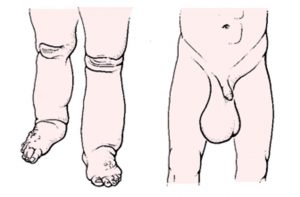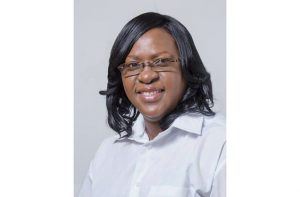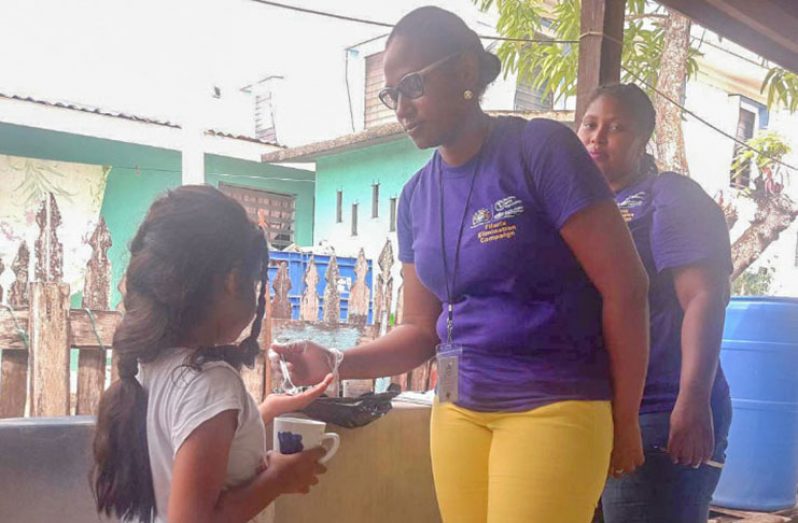AJAY, 75, (not his real name) makes a living by preparing and selling egg balls, plantain chips, channa and sometimes sugar cakes in his corner shop. Nowadays, however, Ajay can no longer easily prepare these local favourites since his left leg is swollen double its usual size.
It all began just over 10 years ago when his left leg first showed signs of swelling. When he spoke to the Guyana Chronicle, he recalled visiting a doctor after his condition prolonged and he was diagnosed with Lymphatic Filariasis (LF) or ‘Filaria’, as it is more commonly called. To him though, it was just “Big Foot.”
LF affects the body’s lymphatic system, which functions to remove unwanted fluids from the body and transports ‘lymph’– a fluid which contains white bloods cells that help to fight infections.
The World Health Organisation (WHO) states that this disease is caused by infection with parasitic worms called nematodes, classified as ‘filarial worms.’ There are three main types of these worms: the wuchereria bancrofti, the brugia malayi and the brugia timori. In Guyana, according to the Coordinator of the Neglected Infectious Disease Programme and the National Coordinator for the Elimination of Lymphatic Filariasis campaign, Dr. Fabu Moses, filaria is caused by the bancrofti worm and is transmitted from human to human by the culex mosquito.

Dr. Moses explained that the conditions of LF may be asymptomatic, acute or chronic. While there are no external manifestations for the asymptomatic conditions, the body’s lymphatic system may still be affected.
And even though someone may be infected, it may take many years before it develops into a chronic condition, which includes the external manifestations of: lymphoedema (tissue swelling), elephantiasis (skin/tissue thickening) of limbs and hydrocele (scrotal swelling).
Attesting to this was Ajay’s 37-year-old daughter, Molly (not real name) who related that he had been infected for more than 20 years, as said by his doctors, before his leg began swelling.
IRREVERSIBLE
For persons like Ajay, however, the chronic signs (swelling of his leg) signal the point of no return.
“There is no cure, prevention is our best option,” Dr. Moses said. The chronic manifestations are irreversible.
Another man who has been infected with the lymphatic disease, John (not real name) a market vendor, explained that he has been living with his swollen leg for 18 years and he has learned to not let it be an impediment to his daily life.
“I does be selling [at the market] everyday, so I don’t get to take care of my leg a lot,” John disclosed. On Sundays, however, he only plies his trade until midday, and as such, he related, “On Sundays I go home and I wash the leg properly; I clean it out and so and I treat it.”
This Sunday regime is part of what Dr. Moses calls the ‘CARE’ system. While there is currently no cure for Lymphatic Filariasis, CARE is an acronym used to guide its treatment. She explained that it is cleaning the affected area, applying treatment, raising the affected area when sitting and above the level of the head when lying down and of course, exercise.
John explained that he learnt about this from his numerous visits to the clinic for his infection and over the years, he has learned to take better care of himself. However, he made no mention of exercising overall or exercising his leg, which according to the doctor is instrumental in caring for oneself.
The overall application of ‘CARE’ is important in abating the morbidity of filaria and it helps to foster good overall health for the person infected.
MASS DRUG ADMINISTRATION
While there is no cure for filaria, promoting the holistic prevention of filaria is now one of the major health focuses in Guyana. But stamping out this is proving to be a challenge.
Guyana was one of the member states that signed onto the WHO’s Global Programme to Eliminate Lymphatic Filariasis by 2020 (GPELF) in 2000, and the country sprang into action by mapping the disease in the country by 2001.
The doctor related, “Mapping is one of the first things we needed to do to be able to guide our interventions.” She explained that the purpose of this was to identify to what extent was the country affected by filaria, what was needed to be done and how these actions would affect a filaria-free future. Guyana was endemic then.
A Mass Drug Administration (MDA) campaign was initiated to remedy the nation, whereby diethylcarbamazine (DEC) fortified salt was distributed to citizens. This proved to be tricky since according to Dr. Moses, it was difficult to determine the number of persons using the DEC salt against their regular cooking salt, whether the quantity being consumed was enough or even if persons consumed the salt in their diets.

Guyana has since been lagging in fulfilling its mandate to eliminate LF and is now one of the four countries in the Americas (in addition to Haiti, The Dominican Republic and Brazil) left to eliminate the disease. Of these four countries however, the WHO report on LF for 2016 shows that Brazil is on track to declare that filaria has been eliminated as a public health problem, while the other two countries have fully implemented their MDAs.
Alarmingly, nine out of the 10 administrative regions of Guyana are considered endemic with filaria, according to Dr. Moses. Region One, Barima-Waini, has a filaria presence of 0.8 per cent, which makes it non-endemic as it is below the one per cent mark.
Thus, at the beginning of October this year, the Ministry of Public Health in conjunction with the Ministry of Education and through support from the Pan-American Heath Organisation/ World Health Organisation (PAHO/WHO) launched a revitalised and re-conceptualised MDA seeking to eradicate the disease from all regions.
It is crafted under the title of “Let’s Prevent Filaria,” which stresses that the disease is NOT treatable, but citizens can safeguard against it through prevention. For this programme to work, a 65 per cent of the total at-risk population must be administered the pills.
The pills, Diethylcarbamazine Citrate (DEC) and Albendazole (ALB) must be taken once every year for five consecutive years for them to be effective in eliminating the disease. Three DEC pills are given, along with one ALB pill; these are responsible for eradicating the bacteria.
The Education Ministry was recruited for this campaign, because as related by the Minister of Education, Nicolette Henry, at the launch of the MDA, it was discovered in the previous campaign that children were the group before that which failed to meet the 65 per cent mark for taking the medication.

Within less than one month of the MDA’s initiation, schools have already been engaged in administering of the pills. Dissent forms were however given to every student so that the pills would not be administered when parents do not wish their children to take them.
However, principal of Queen’s College — one of the first schools to begin the administration, Jackie Benn — decided to invite ministry officials into the school beforehand to educate students as to why they should take the tablets. According to her, students should know why they are taking the pills.
Besides targeting schools, officials have been disseminating pills at health centres and other public places and even going a step further to visit homes. This, as related by the Junior Minister of Public Health Dr. Karen Cummings through an invited comment, is part of the effort to ensure that every Guyanese take their pills to safeguard against the ailment.
In addition to the MDA, Dr. Cummings related that the ministry is employing other tactics to eliminate filaria.
“We have these areas fogged, to kill the mosquitoes and the larvae and for pregnant women, we have been giving mosquito-treated nets,” she said, adding that a coordinated effort across many of the sectors under the Health Ministry has been employed as a strategy to eliminate the disease-carrying mosquitoes.
Minister Cummings highlighted that in addition to actively tackling the spread of the disease through disseminating drugs and suppressing the spread of mosquitoes, another major tenet of the campaign is awareness.
While John was apprehensive of the MDA, he did contend that awareness is a critical part of eliminating the disease. As he stood beside his market stall, he postulated: “You see this gutter here? You see how it full of grass? People got to understand that these things does breed mosquitoes and they [the mosquitoes] does bring all kinda disease, [sic] not only filaria.”
The Health Ministry has been carrying out awareness sessions in areas where evidence-based studies have shown are more endemic.
The collaboration with the education sector, however, not only seeks to encourage youths to take their pills to safeguard against the disease, but to also provide a holistic approach to the awareness of the disease, including the other measures of prevention and the signs and symptoms.
A FILARIA-FREE GUYANA
Filaria has been described by the WHO as one of the oldest and most debilitating neglected tropical diseases. While many countries have been able to eliminate the disease after signing onto the global resolution, Guyana has fallen behind in this regard.
“We are one of the few countries that still have this disease in this part of the Americas,” the public health minister bemoaned and due to cognisance of this, she highlighted that her ministry has been working assiduously to entirely eliminate it.
Dr. Moses, like the health minister, explained that the disease is compounded by other issues such as accessibility (reaching outlying regions), lack of human resources and the general stigmas associated with the disease.
“A lot of people do not go to the clinic because they tend to hide their disease, since it is very stigmatized — especially when people use words like ‘bigfoot’ and ‘goadie’,” Dr. Moses said.
Both filaria victims, Ajay and John, mentioned that they were faced with stigma and discrimination, especially in their professional lives.
“My customers never really said anything to me, but now and then somebody gon come and say something and me and them does gotta go up the road,” John remarked.
Despite the prevalence of the disease and the challenges that accompany it, there is much hope still.
As related by Chief Medical Officer Dr. Shamdeo Persaud at the campaign’s launch, “From more than 150 patients that we were seeing in the mid-2000s, now they are only about 15 patients who have to be actively managed at the clinic. Last year there were only 82 surgeries for hydrocele as compared to 447 in 2005.”
With these strides in mind, it is now up to the general population to take their pills and safeguard against mosquitoes. As explicitly stated by Dr. Moses, “The goal of our programme is eliminating filaria as a public health problem; that means getting filaria under one percent in the entire population.




.jpg)










